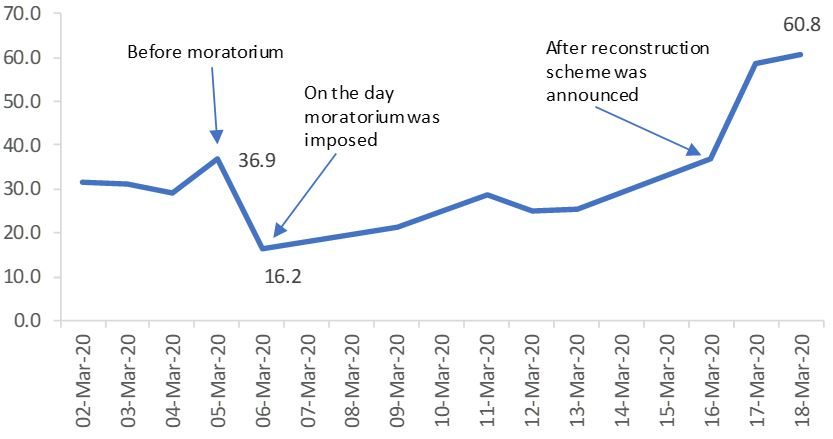Yes Bank Fiasco: End of AT1 bond issuance in India?
Published on 20 Mar, 2020

Yes Bank had been under stress for some time, marred by low capital adequacy and asset quality issues. RBI, which had been monitoring the situation closely, has now decided to step in and act decisively. Its sudden decision to impose a moratorium and announce restructuring has caught markets and investors unaware. One of the casualties of the proposed restructuring are the AT1 bondholders, whose entire investments would be written down and rendered worthless. This then raises the question: is the solution viable? Is this the first time that bonds are being written down, while equity investors are being compensated?
Yes Bank’s stock has been soaring, contrary to the widespread fall in Indian equities, driven by the positive news of rescue by SBI and upcoming removal of restrictions on deposit withdrawals. However, fixed income investors have been dealt a severe blow. Investors in additional Tier 1 (AT1) bonds of Yes Bank received a rude shock on March 15 after the bank announced that it will write down AT1 bonds worth INR84.15bn to zero. This includes the perpetual subordinated Basel III-compliant bonds worth:
- INR30.00bn issued on December 23, 2016; and
- INR54.15bn issued on October 18, 2017.
The write-down implies bond investors are paying for the excesses committed by the management. The write-down is the last chapter in the bank’s bailout proceedings that started with RBI placing Yes Bank under moratorium on March 5 and replacing its board after its near failure. On March 13, RBI announced a reconstruction scheme worth INR100bn led by SBI, which will now own a 49% stake in Yes Bank. The scheme prescribes a three-year lock-in period for shareholders holding more than 100 shares. The scheme will protect depositors, senior bondholders and equity shareholders, but AT1 bondholders have been left in the lurch with total write-down of their holdings.
What are AT1 bonds?
AT1 bonds are additional Tier 1 bonds issued by banks to boost their capitalization. As of 2019, Indian banks need to maintain a minimum common equity ratio (CET1 ratio) of 8%, Tier 1 ratio of 9.5% and total capital ratio (capital adequacy ratio) of 11.5%. These capital requirements are 1% higher than the Basel requirements. The 8% requirement needs to be met by common equity and retained earnings, 1.5% can be met through AT1 bonds and the remaining 2.0% through Tier 2 bonds.
AT1 bonds are Basel III-compliant that act as buffers for banks in times of stress; hence, they are quasi-equity in nature. These are subordinated-perpetual bonds with a call option in five years. Other key features of AT1 bonds are capital trigger and principal loss-absorption. Once the issuing bank’s capital falls below a certain level, the trigger gets activated and the bonds can be partly or fully written down on a temporary or permanent basis or the bonds can be converted into equity. Basel regulations also allow for a discretionary trigger called as the Point of Non-Viability Trigger (PONV), which can be activated by a country’s banking regulator, if it believes that such action is necessary to prevent the issuing bank’s insolvency.
Investors in AT1 bonds face an additional risk of non-payment of coupon. In case, a bank makes losses in a particular year, and if its capitalization goes below the minimum threshold on payment of coupons, the bank has the discretion to skip coupon payment on its AT1 bonds. The coupons are non-cumulative, and the bank has no obligation to pay the missed coupon.
What happened with Yes Bank AT1 bonds?
Under the restructuring scheme announced on March 14, RBI proposed a complete write-down of AT1 bonds worth INR84.15bn, while protecting equity holders’ interests. RBI plans to recapitalize the bank by injecting equity totaling INR100bn, led by SBI and other lenders, with a three-year lock-in period.
On March 14, Yes Bank announced results for Q3 20, posting a net loss of INR185.60bn. The bank’s CET1 ratio fell to 0.6% in Q3 20 from 8.7% in Q2 20, while capital adequacy ratio slipped to 4.1% from 16.3% over this period. The weakening of financial position was attributed to the bank booking significant provisions (INR247.66bn) in Q3 20, given the deterioration in asset quality. Gross NPL ratio rose to 18.9% in Q3 20 from 7.4% in Q2 20.
Prior to the announcement of moratorium, Yes Bank’s shares were trading at INR36.8; the share price slid to INR16.15 on March 6 following the imposition. Subsequent to the news of the restructuring scheme, Yes Bank’s shares have rallied significantly to touch INR60.80 as of March 18; while this means extraordinary gains for equity holders, AT1 bondholders’ hopes have been dashed.
Yes Bank Share Price Performance

Source: MoneyControl
Key Features of the Yes Bank AT1 bonds
Amount Issued | INR30.00bn | INR54.15bn |
Issue Date | December 23, 2016 | October 18, 2017 |
Coupon | 9.50% | 9.00% |
Maturity | Perpetual | Perpetual |
Ranking | Subordinated | Subordinated |
Basel III compliance | Yes | Yes |
Secured/Unsecured | Unsecured | Unsecured |
Convertible/Non-Convertible | Convertible | Non-Convertible |
Coupon Discretion | Yes | Yes |
Loss Absorbency | Upon occurrence of the following trigger events:
| |
Pre-specified trigger level | If CET1 falls below 5.5% of RWA before 31 March 2019 | |
PONV trigger | The earlier of:
| |
Whether AT1 can be written off before equity capital | Yes under both events |
|
Source: Yes Bank Bond Offer Document
In a global context, this is not the first time AT1 bonds are facing losses. Although technically AT1 bonds are liable for losses, going by the precedent globally, they have always been accompanied by an equal or more severe loss to equity shareholders. However, in the case of Yes Bank, AT1 bondholders are worse off compared to equity shareholders.
Global precedents
Banco Popular’s EUR1.25bn AT1 write-down – A case of resolution without state aid
On June 7, 2017, the Single Resolution Board (SRB), EU’s Central Resolution Authority for banks, put Spanish lender Banco Popular under resolution. The bank was considered likely to fail, given the significant outflow of deposits and deterioration in asset quality. The capital hole was plugged by writing off AT1 bonds worth EUR1.25bn and equity shares worth EUR1.38bn (Banco Popular’s shares were trading at EUR0.33 before suspension); and issue of fresh equity worth EUR7bn by acquiror Banco Santander. Under the European Commission’s directive, Banco Santander took over Banco Popular for a symbolic value of EUR1. The Tier 2 instruments were converted into equity. The AT1 write-off was in line with the bail-in resolutions applicable for European banks as per the Bank Recovery and Resolution Directive (BRRD).
Institutional investors PIMCO, Anchorage Capital Group, Algebris Investments, Ronit Capital and Cairn Capital filed a lawsuit in the European Court of Justice against EU authorities for not conducting a definitive valuation of the lender. The lawsuit is ongoing.
For retail investors, Banco Santander launched a EUR1bn scheme. Under it, fresh bonds were to be issued free to customers on condition that their rights to pursue legal action against Santander would be waived off. The bonds would be perpetual but redeemable after 7 years and would pay 1% interest annually. The voluntary measure was aimed at maintaining customer relationships.
Monte Dei Paschi Di Siena’s AT1 and T2 bond swap: A case of state bailout
In July 2017, Italian lender Monte Paschi was given a EUR5.4bn state bailout in conjunction with a deal to swap EUR4.3bn of subordinated bonds with equity. The bank’s capital shortfall was EUR8.1bn and the bailout resulted in the state owning a c70% stake in the bank.
The bank offered 100% of face value for T2 bonds and 75% for T1 bonds. Monte Paschi earmarked EUR1.5bn to compensate retail junior bondholders who were mis-sold the bonds.
Banco Espirito Santo’s EUR2bn senior bond wipe off – A case of selective loss imposition
Portugal’s private bank Banco Espirito Santo (BES) failed in 2014 due to fraudulent activities conducted by the Espirito Santo family, its private owners. The Portuguese central bank announced a resolution plan under which BES was split into a “bad bank” with toxic assets; and a “good bank” Novo Banco. The bad bank housed those shareholders and subordinated debtors who were to be written down against the bad assets that mainly consisted of exposure to Espirito Santo Group companies and BES’s Angolan unit; the new bank, on the other hand, housed depositors, senior debtors and other viable assets. The good bank was recapitalized by EUR4.9bn from the Portuguese Resolution Fund.
On December 29, 2014, the Portuguese central bank decided to transfer senior bonds worth EUR2bn from Novo Banco to BES, essentially making them worthless. The central bank selected 5 out of 52 outstanding bonds to be transferred to the bad bank. The transfer was meant to plug a EUR1.4bn capital shortfall in Novo Banco. The senior bonds were not owned by retail investors. Institutional investors such as BlackRock and Pimco that were holding the senior bonds launched legal action against the Bank of Portugal, which is still under review by the court of law.
Conclusion & Key Takeaways
In all the instances mentioned above, equity shareholders’ value was also wiped out along with AT1 bondholders’ value. Moreover, wherever retail investors were impacted, authorities have taken steps to protect their interests. However, in the context of Yes Bank, this is the first time in history that losses are being fully imposed on AT1 bondholders, while equity shareholders are being compensated and are even enjoying the rewards of the uptick in share prices following the announcement of restructuring. Retail investors have also been left holding the short end of the stick.
The key takeaways from this episode:
- A better price discovery process is required for AT1 bonds to accurately reflect the underlying risks.
- Investors should be educated more widely to make them aware of the features of AT1 bonds, especially highlighting risks involved in case the bank fails.
- Strict regulatory action needs to be taken regarding mis-selling of AT1 bonds.
- Selling AT1 bonds to retail investors should be strictly prohibited.
- AT1 bondholders should be compensated in line with international norms in case the bank fails.
- Compensation needs to be provided to protect the interest of vulnerable retail investors in AT1 bonds who were not fully aware of the risks and to whom the bonds were mis-sold.
There is an urgent need to implement the measures mentioned above for the revival and sustenance of the AT1 bond market in India.
